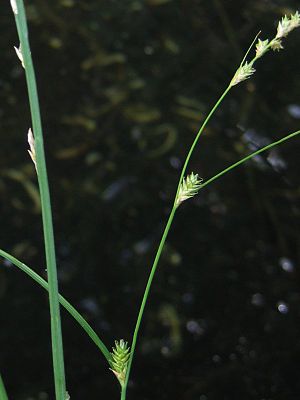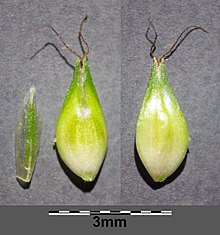Angle sedge
| Angle sedge | ||||||||||||
|---|---|---|---|---|---|---|---|---|---|---|---|---|

Angle sedge ( Carex remota ) |
||||||||||||
| Systematics | ||||||||||||
|
||||||||||||
| Scientific name | ||||||||||||
| Carex remota | ||||||||||||
| L. |
The angular sedge ( Carex remota ) is a species of the genus Seggen ( Carex ) within the sour grass family (Cyperaceae). It is common in Eurasia .
description
The angle sedge is an evergreen , perennial herbaceous plant that reaches heights of 20 to 60, rarely up to 100 centimeters. It does not form runners , but small to medium-sized clumps . Its stem is leafy up to the top, relatively slack and tender and often overhanging when ripe and is held together at the bottom by long sheaths. The upper struts therefore form a stalked rosette with knots that can be felt at the base. The light green leaves are 1 to 2 millimeters wide, are runny or simply folded and tapering into an indistinct long triangular tip. They have flat-arched ligules at the base.
The annual inflorescence contains six to nine spikelets. The 4 to 10 millimeter long spikelets are quite close together at the upper end of the inflorescence, but are far apart from each other towards the bottom. In contrast to some other sedge species, the angle sedge has female spikelets at the tip and the male at the base. The long bracts of the spikelets tower above them and are leaf-like, the bracts are whitish. Each spikelet consists of upright wingless, yellow-green tubes (utriculi) that are about 3 millimeters long and 1.5 millimeters wide. The spikelets are flat on the inside and domed on the outside, so they appear oblong-ovate. They are provided with a relatively long two-toothed beak . Each tube also encloses two scars.
The number of chromosomes is 2n = 62.
ecology
The angle sedge is a hemicryptophyte . However, it also reproduces vegetatively with the help of its rhizome . It belongs to the clump-forming sedges.
The flowering time is in June and July. The pollination is carried by the wind ( anemophily ). The floating diaspores are spread out by the water ( hydrochory ) or by the wind ( anemochory ).
Occurrence
The corner sedge occurs in Europe and in large parts of Asia to Japan and Malesia. It also has occurrences in North Africa. It is a typical floral element of the damp forest edges.
It is common in all of Germany except for the Central German dry areas. It settles on the shady banks of water and moors, but also in damp ash or alder forests, in damp mixed beech forests and, more rarely, on forest paths. It is a gley or pseudogley pointer.
It is in Central Europe, a characteristic species of Carici-remotae-Fraxinetum from the Association of Alno Ulmion. But it also occurs in other associations of the Alno-Ulmion, Fagion, Carpinion or Cardamino-Montion associations.
In the Allgäu Alps , it rises on the Reuterwanne near Wertach in Bavaria to an altitude of 1,300 meters.
Systematics
One can distinguish the following subspecies and varieties:
- Carex remota subsp. remota : It occurs in North Africa and from Europe to the western Himalayas.
- Carex remota var. Remotispicula (Hayata) Ohwi : It occurs from central and southern China to Taiwan.
- Carex remota var. Reptans Franch. : It occurs in central China.
- Carex remota subsp. rochebrunei (Franch. & Sav.) Kük. : It occurs from southeast China to Japan, from Sumatra to western Java and on the Indian subcontinent.
- Carex remota subsp. stewartii Kukkonen : It occurs from eastern Afghanistan to the Himalayas.
literature
- Rudolf Schubert, Walter Vent (Ed.): Excursion flora from Germany. Vascular plants: Critical volume (founded by Werner Rothmaler ). 8th edition. Gustav Fischer, Jena 1994, ISBN 3-334-60830-1 .
- E. Foerster: Sedges, rushes, ledges and other mock grasses of grassland - a key to determining in the flowerless state. Kleve-Kellen manuscript, March 1982.
- Angle sedge. In: FloraWeb.de.
Individual evidence
- ↑ Fitschen, Jost, 1869-1947, Parolly, Gerald., Rohwer, Jens G., 1958-, Koltzenburg, Michael., Schmidt, Peter A., 1946-: The flora of Germany and neighboring countries: a book to determine all wild growing and often cultivated vascular plants . 96th, completely revised and expanded edition. Wiebelsheim 2016, ISBN 978-3-494-01562-0 .
- ↑ a b c Erich Oberdorfer : Plant-sociological excursion flora for Germany and neighboring areas . With the collaboration of Angelika Schwabe and Theo Müller. 8th, heavily revised and expanded edition. Eugen Ulmer, Stuttgart (Hohenheim) 2001, ISBN 3-8001-3131-5 .
- ↑ a b c d e f g Rafaël Govaerts (Ed.): Carex remota. In: World Checklist of Selected Plant Families (WCSP) - The Board of Trustees of the Royal Botanic Gardens, Kew . Retrieved October 15, 2016.
- ↑ Erhard Dörr, Wolfgang Lippert : Flora of the Allgäu and its surroundings. Volume 1, IHW, Eching 2001, ISBN 3-930167-50-6 , p. 253.
Web links
- Carex remota L., angle sedge. In: FloraWeb.de.
- Angle sedge . In: BiolFlor, the database of biological-ecological characteristics of the flora of Germany.
- Profile and distribution map for Bavaria . In: Botanical Information Hub of Bavaria .
- Carex remota L. In: Info Flora , the national data and information center for Swiss flora .
- Distribution in the northern hemisphere from: Eric Hultén, Magnus Fries: Atlas of North European vascular plants. 1986, ISBN 3-87429-263-0 at Den virtuella floran. (swed.)
- Thomas Meyer: Data sheet with identification key and photos at Flora-de: Flora von Deutschland (old name of the website: Flowers in Swabia )
- Carex remota inthe IUCN 2013 Red List of Threatened Species . Posted by: S. Contu, 2009. Retrieved April 12, 2014.



